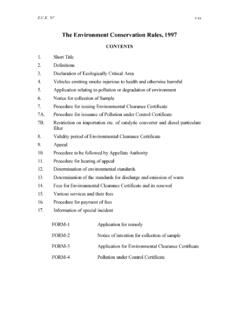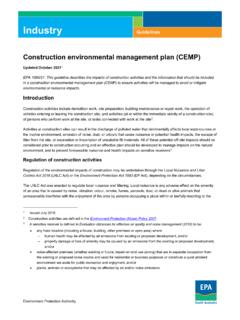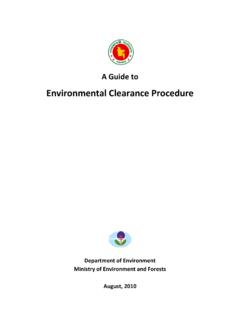Transcription of CHAPTER 15: ENVIRONMENTAL REVIEW - HUD
1 CHAPTER 15: ENVIRONMENTAL REVIEW . CHAPTER PURPOSE & CONTENTS. This CHAPTER provides grantees with general information on ENVIRONMENTAL REVIEW . The CHAPTER will provide an overview of the applicable regulations, responsibilities, guidance on classifying the activity and the appropriate level of REVIEW . Grantees must consult the regulations (cited within this CHAPTER ) and their HUD ENVIRONMENTAL Representative for more detailed guidance than this CHAPTER can provide. SECTION TOPIC. Overview of ENVIRONMENTAL Requirements Overview of the ENVIRONMENTAL Requirements Background and Applicable Regulations The purpose of the ENVIRONMENTAL REVIEW process is to analyze the effect a proposed project will have on the people and the natural environment within a designated project area and the effect the material and social environment may have on a project.
2 Grantees who receive CDBG funds are considered responsible entities and must complete an ENVIRONMENTAL REVIEW of all project activities prior to obligating CDBG funds. This requirement also applies to projects funded with CDBG generated program income. The HUD rules and regulations that govern the ENVIRONMENTAL REVIEW process can be found at 24 CFR Part 58. The provisions of the National ENVIRONMENTAL Policy Act (NEPA) and the Council on ENVIRONMENTAL Quality (CEQ) regulations in 40 CFR Parts 1500 through 1508 also apply. In addition, a myriad of other Federal and state laws and regulations (some of which are enforced by State agencies) also apply depending upon the type of project and the level of REVIEW required. The following is a summary of applicable statutory and regulatory cites and other reference materials available from HUD: Key Topics in This Section: Applicable ENVIRONMENTAL rules, Legal responsibilities, Triggering actions, Classifying the activity Regulatory/Statutory Citations: 24 CFR Part 58, , 40 CFR Part 1500-1508.
3 Other Reference Materials on This Topic HUD's Office of Environment and Energy: , HUD's ENVIRONMENTAL REVIEW Requirements: HUD's Frequently Asked ENVIRONMENTAL Questions and Answers: , CPD Notice 02-07. Basically CDBG (November 2007) 15-1. HUD, Office of Block Grant Assistance CHAPTER 15: ENVIRONMENTAL REVIEW The Responsible Entity & Official Designations Under 24 CFR Part 58, the term responsible entity (RE) means the grantee receiving CDBG. assistance. The responsible entity must complete the ENVIRONMENTAL REVIEW process. The RE is responsible for ensuring compliance with NEPA and the Federal laws and authorities has been achieved, for issuing the public notification, for submitting the request for release of funds and certification, when required, and for ensuring the ENVIRONMENTAL REVIEW Record (ERR) is complete.
4 In order to fulfill its obligations under 24 CFR Part 58, the RE should designate two responsible parties: Certifying Officer: The responsible entity must designate a Certifying Officer -- the responsible Federal official -- to ensure compliance with the National ENVIRONMENTAL Policy Act (NEPA) and the Federal laws and authorities cited at section has been achieved. This person is the chief elected official, chief executive official, or other official designated by formal resolution of the governing body. The certifying officer must have the authority to assume legal responsibility for certifying that all ENVIRONMENTAL requirements have been followed. This function may not be assumed by administering agencies or consultants. ENVIRONMENTAL Officer: The funding recipient should also designate an ENVIRONMENTAL Officer.
5 The ENVIRONMENTAL Officer is responsible for conducting the ENVIRONMENTAL REVIEW including such tasks as: writing the project narrative, obtaining maps of the project area, soliciting comments from appropriate local, state and federal agencies, and facilitating responses to comments received on the ENVIRONMENTAL findings. ENVIRONMENTAL REVIEW Record Each responsible entity must prepare and maintain a written record of the ENVIRONMENTAL REVIEW undertaken for each project. This written record or file is called the ENVIRONMENTAL REVIEW Record (ERR), and it must be available for public REVIEW upon request. The ERR shall contain all the ENVIRONMENTAL REVIEW documents, public notices (and proof of their publication), and written determinations or ENVIRONMENTAL findings required by 24 CFR Part 58 as evidence of REVIEW , decision making and actions pertaining to a particular project.
6 The document shall: Describe the project and each of the activities comprising the project, regardless of individual activity funding source; and Evaluate the effects of the project or the activities on the human environment;. Document compliance with applicable statutes and authorities; and Record the written determinations and other REVIEW findings required by 24 CFR Part 58. The ERR will vary in length and content depending upon the level of REVIEW required for the categories of activities. Public comments, concerns and appropriate resolution by the recipient are extremely important and must be fully documented in the ERR. Basically CDBG (November 2007) 15-2. HUD, Office of Block Grant Assistance CHAPTER 15: ENVIRONMENTAL REVIEW Actions Triggering ENVIRONMENTAL REVIEW and Limitations Pending clearance According to the NEPA (40 CFR 1500-1508) and Part 58, the responsible entity is required to ensure that ENVIRONMENTAL information is available before decisions are made and before actions are taken.
7 In order to achieve this objective, Part 58 prohibits the commitment or expenditure of CDBG funds until the ENVIRONMENTAL REVIEW process has been completed and, if required, the grantee receives a release of funds. Grantees may not spend either public or private funds (CDBG, other Federal or non- Federal funds), or execute a legally binding agreement for property acquisition, rehabilitation, conversion, repair or construction pertaining to a specific site until ENVIRONMENTAL clearance has been achieved. Grantees must avoid any and all actions that would preclude the selection of alternative choices before a final decision is made that decision being based upon an understanding of the ENVIRONMENTAL consequences and actions that can protect, restore and enhance the human environment ( , the natural, physical, social and economic environment).
8 Activities that have physical impacts or which limit the choice of alternatives cannot be undertaken, even with the grantee or other project participant's own funds, prior to obtaining ENVIRONMENTAL clearance . For the purposes of the ENVIRONMENTAL REVIEW process, commitment of funds includes: Execution of a legally binding agreement (such as a property purchase or construction contract);. Expenditure of CDBG funds;. Use of non-CDBG funds on actions that would have an adverse impact--- , demolition, dredging, filling, excavating; and Use of non-CDBG funds on actions that would be choice limiting --- , acquisition of real property; leasing property; rehabilitation, demolition, construction of buildings or structures; relocating buildings or structures, conversion of land or buildings/structures.
9 It is acceptable for grantees to execute non-legally binding agreements prior to completion of the ENVIRONMENTAL REVIEW process. A non-legally binding agreement contains stipulations that ensure the project participant does not have a legal claim to any amount of CDBG funds to be used for the specific project or site until the ENVIRONMENTAL REVIEW process is satisfactorily completed. Classifying the Activity and Conducting the Appropriate Level of REVIEW To begin the ENVIRONMENTAL REVIEW process, funding recipients must first determine the ENVIRONMENTAL classification of the project. The term project can be defined as an activity or group of activities geographically, functionally, or integrally related, regardless of funding source, to be undertaken by the CDBG recipient, subrecipient, or a public or private entity in whole or in part to accomplish a specific objective.
10 Basically CDBG (November 2007) 15-3. HUD, Office of Block Grant Assistance CHAPTER 15: ENVIRONMENTAL REVIEW If various project activities have different classifications, the recipient must follow the REVIEW steps required for the most stringent classification. The four ENVIRONMENTAL classifications are: Exempt Activities, Categorically Excluded Activities, Activities Requiring an Environment Assessment, or Activities Requiring an ENVIRONMENTAL Impact Statement. Regardless of the number of activities associated with a project, a single ENVIRONMENTAL REVIEW is required. Aggregating related activities ensures the recipient adequately addresses and analyzes the separate and combined impacts of a proposed project. Exempt Activities Certain activities are by their nature highly unlikely to have any direct impact on the environment.


















